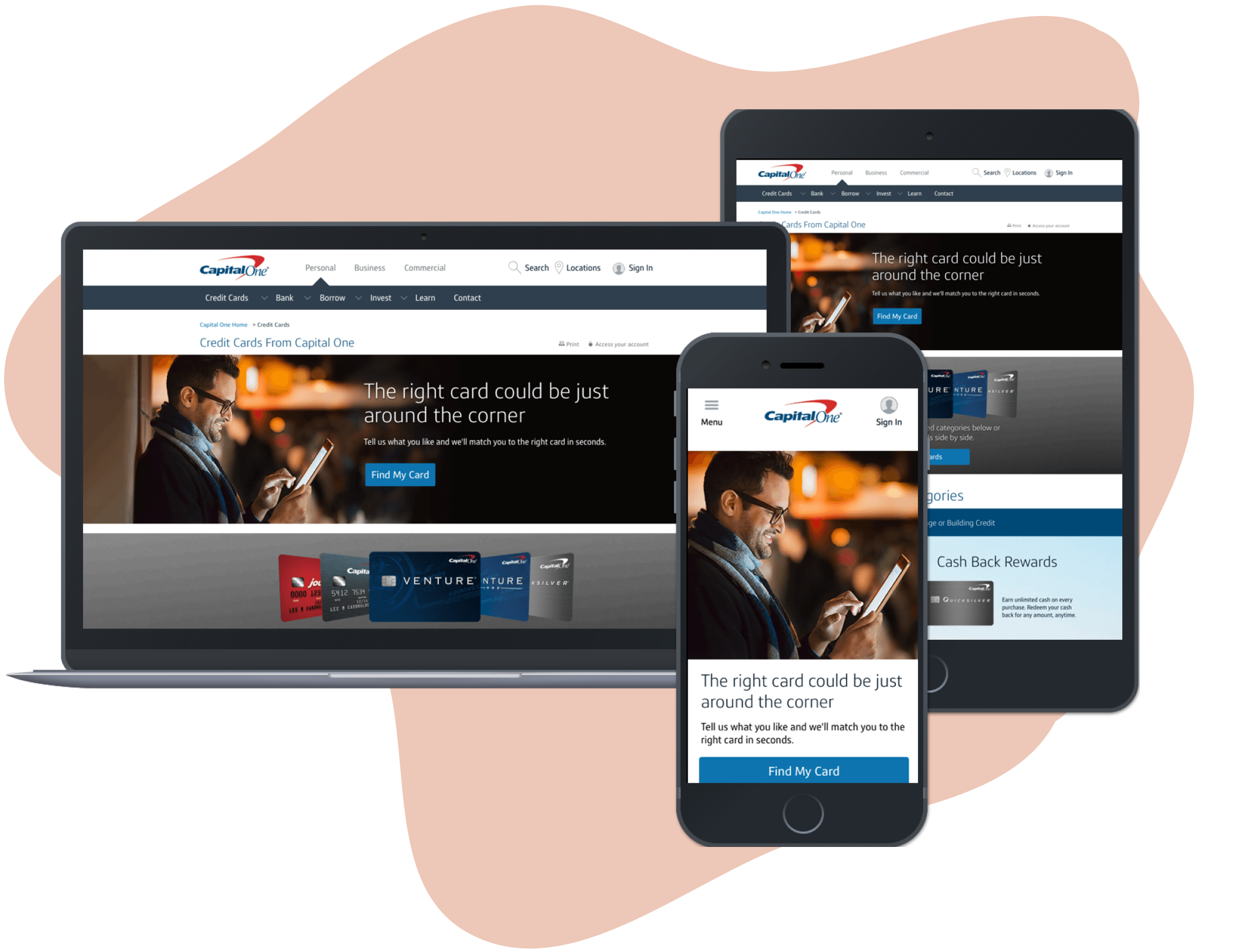Personalization
At Capital One, I led the design of a proof-of-concept personalization framework for the Credit Card Home Page, using existing machine learning models to deliver targeted product recommendations. In just 20 days and 30% of traffic, the initiative drove a 49% lift in prequalified offer engagement, improved product fit, and reduced regulatory risk—laying the groundwork for a scalable, data-driven personalization system.

Success Metrics
Defined and tracked performance across three key performance indicators:
Find the Right Product
Goal: Connect users with the most relevant credit card at the right moment.
Metric: Increase in prequalified offer engagement and successful product bookings.
Result: 49% lift in prequalified offers (Test A), 21% lift in VentureOne bookings, 17% lift in Quicksilver bookings (Test B).
Operationalize Personalization
Goal: Pilot a predictive capability using existing machine learning models on the Credit Card Home Page.
Metric: Test performance vs control for targeted card recommendations.
Tool: A/B testing framework with data science collaboration.
Reduce Regulatory Risk
Goal: Minimize unqualified card selections that result in hard credit checks.
Metric: Decrease in mismatch between user qualifications and selected products.
Tool: Model-based targeting informed by past compliance-related incidents.
Design Opportunity
User Problem
40% of users selected the wrong credit card, leading to poor product fit.
Many missed out on eligible rewards by choosing no-reward cards despite high credit scores.
Others triggered hard credit checks by applying for cards they didn’t qualify for.
These missteps introduced friction in the journey and eroded user trust in the experience.
Business Problem
Incorrect card selections led to lost revenue and reduced conversion efficiency.
Hard credit checks on unqualified users exposed the business to compliance risks.
Violations of key regulations like the Fair Lending Act and Fair Credit Billing Act became a growing concern.
The business needed to improve product alignment, enhance user experience, and reduce regulatory risk through smarter personalization.

Team Structure & Collaboration
This initiative brought together design, data, marketing, and engineering partners across multiple departments. As the lead interactive designer, I worked closely with a Senior Business Analyst to proactively pitch and socialize the concept with senior leadership to secure buy-in, accelerate alignment, and scale impact.
Core Team
Lead Interactive Designer - (my role)
Sr. Business Analyst
Supporting Roles
Marketing Manager
Product Owner
Data Analyst
Data Scientist
Lead UX Engineer
Sr. Engineer
Jr. Engineer
Key Stakeholders & Socialized Teams
Brand Executive Leadership Team
Enterprise Executive Leadership Team
Card Executive Leadership Team
Enterprise Design Team
Creative Branding Team
Card Product Managers
Marketing Teams
Enterprise Tech Team
Key Decisions & Process
Build Cross-Functional Alignment
To secure buy-in, I led the creation of a visual board and collaborated with my team to present the concept at the Dart Science Fair, an internal innovation showcase. Together, we pitched the value of personalization, which helped build momentum, earn leadership support, and expand our team from 2 to 10. This milestone marked my transition into a coach/player leadership role, guiding both strategy and team development.
FAST Marketing Poster: Predictive Martech for User Identification
New Capability Marketing Poster
Future of Online Testing Marketing Poster
Images from DART Science Fair

Design and Execute the A/B Test Strategy
Working with a data scientist and a marketing lead, I led the design of two test variations informed by prior research and historical user behavior. Instead of building new models, I pitched reusing Capital One’s existing machine learning models, which were originally developed for marketing campaigns, and integrating them into the product experience. This approach accelerated delivery and enabled us to launch a high-impact personalization test across 30% of site traffic with minimal technical lift, directly tied to key business KPIs.
Draft Test Design Outline
Wireframes
Proof of Concept
I led a proof of concept to validate the business impact of real-time personalization using existing machine learning models. Our goal was to improve product fit and increase conversions by aligning recommendations with user behavior and creditworthiness. We launched the test in just 20 days, using 30% of site traffic.
Results:
Test A: 49% increase in prequalified offer engagement
Test B: 21% lift in VentureOne bookings and 17% lift in Quicksilver bookings
Demonstrated clear alignment between personalization strategy and business KPIs including engagement, conversion, and satisfaction
Test A
Test B

Learnings
Leverage What You Already Have
Using pre-existing ML models allowed us to move faster, validate hypotheses, and show ROI without building a new tech stack.
Design-Led Strategy Unlocks Business Value
Positioning design as a strategic driver (not just execution) enabled cross-team alignment and rapid team growth—turning an idea into a validated solution in less than a month.
Personalization Reduces Risk, Increase Fit
Aligning product recommendations to user behavior not only improved engagement, but also helped avoid regulatory missteps and reduce friction.
Internal Storytelling Drives Buy-In
The science fair booth created clarity around a complex idea and helped secure the leadership support needed to scale.
Explore More Case Studies
Driving Business Outcomes Through Leadership
From personalization and GPS-based experiences to extended reality (XR) and enterprise-scale ecosystems, each case study highlights a unique facet of how I lead research, strategy, and user-centered solutions that drive meaningful impact.














